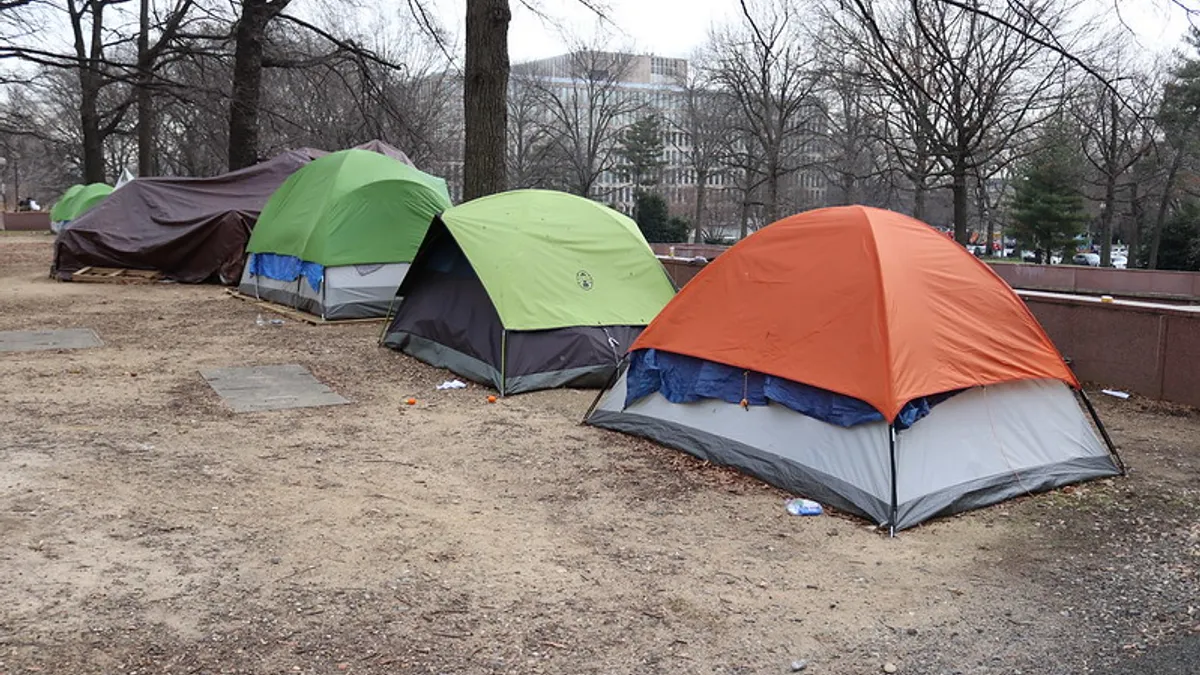Dive Brief:
- The U.S. Department of Housing and Urban Development's (HUD) count of people experiencing homelessness is likely an underestimate, according to a recent Government Accountability Office (GAO) report.
- The report also found that the median rent increase of $100 per month was associated with a 9% spike in homelessness.
- GAO analyzed three sources of HUD data and "developed an econometric model of the factors influencing changes in homelessness," in addition to conducting interviews and visiting three major cities — Colorado Springs, CO, Los Angeles, and New York — that saw recent spikes in homelessness.
Dive Insight:
The rate of homelessness increased for the past three years in a row, according to HUD. The national rate increased 2.7% last year, or 567,715 people on a single night in 2019. And California experienced a 16.4% increase, more than the total increase of every other state combined.
The GAO report highlights the limitations of HUD's Point-In-Time (PIT) count for determining those figures. The PIT count is a "snapshot look at how many people are experiencing homelessness on a given day in a given year," GAO Director of Financial Markets and Community Development Alicia Puente Cackley said. It's not catching those who may have experienced homelessness on a different day that year, or those who might be doubled up or couch surfing, or sheltering somewhere that's not visible to counters, she said.
Some of the counts conducted by Continuums of Care (CoC), or the local groups that coordinate homeless resources and apply for grants with HUD, have significant year-over-year fluctuations, which "raise questions about data accuracy," according to the report.
The GAO found, for example, that HUD doesn’t closely analyze CoCs' methodologies for data collection to guarantee they meet HUD standards. By improving the oversight and guidance to CoCs in certain areas, HUD could enhance the quality of their data on rates of homelessness, according to the report.
Rep. Maxine Waters, D-CA, requested the report in 2018 to better address the root causes of homelessness. "The U.S. is one of the richest, wealthiest, countries in the world, and it is shameful that so many across the nation, including in my city of Los Angeles, are living on the streets," Waters said in a statement.
More accurate counts are crucial for a number of reasons. "The more accurate the count, the better job HUD can do about ensuring that services are available where the need is greatest," Cackley said. "If you're undercounting, you’re not necessarily putting the money where it needs to go."
Currently, HUD has administered $4 billion total in emergency solution grants during the pandemic to communities with high homeless populations or with people at-risk of becoming homeless. The funding has been used to increase the availability of emergency shelters; operate those shelters; provide hotel or motel vouchers; and provide essential services like mental health and legal aid.
Some advocates and city officials have called for far more funding. A March 2020 report from researchers at the University of Pennsylvania, University of California Los Angeles and Boston University found that $11.5 billion is needed to properly address the protections required for people experiencing homelessness during the pandemic.
More accurate figures can also help cities address affordable housing needs, something that many officials are looking to as the country braces for a "tidal wave of evictions."












